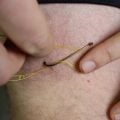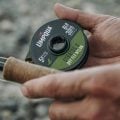How to Tie a Leisenring Spider
Producer: Tim Flagler
This truly classic-looking fly is called a Leisenring Spider. I have deviated significantly from the original pattern in terms of the tying sequence and techniques, but I think the end result is fairly close to what Mr. Leisenring intended.
Rather than going old school, I begin with a modern-looking, Fulling Mill 5105 barbless hook in size 14. After getting the hook firmly secured in the jaws of my tying vise, I load a bobbin with a spool of yellow UTC 70 Denier.
Get your thread started on the hook shank leaving a little space behind the eye and take a few wraps rearward before snipping off the tag.
Small-sized gold Ultra wire is used to rib and segment the fly, a 6” length will make numerous flies. Place one end of the wire on top of the hook shank and begin securing it with wraps of tying thread. Keep taking wraps rearward all the way to the start of the hook bend then forward to about 1/3 of the way down the shank from the eye. End with your thread at about the hook point.
Natural light hare’s mask dubbing is used to create the body of the fly. Pluck an ample clump free from the package. Pull down on your bobbin to expose about 3” of tying thread. Use the dubbing to create a fairly thin 2” long noodle on the thread. Try to keep it nice and slender. Double your tying thread over and take a wrap around the hook shank and then around the legs of the loop to close it down. Advance your tying thread forward to about an eye-length behind the hook eye. Insert a dubbing whirl into the loop and give it a real good clockwise spin. Watch the noodle as you twist, and keep on twisting until the yellow thread all but disappears. A small piece of velcro, the hook kind, does a great job of gently pulling out fibers to make the dubbing noodle fuzzy.
Rather than wrapping with the whirl, I find it easier to get hold of the noodle with plunger-style hackle pliers and take a wrap or two before closing them. This ensures they won’t slip down on the tying thread and allows you to snip the whirl free. Start taking wraps with the noodle so the dubbing begins almost at the hook bend. Traditionally a small amount of yellow thread is left exposed at the very end of the fly. Continue taking touching wraps forward with the noodle to build up a fuzzy body. When you reach your tying thread, use it to anchor the noodle then snip the excess off close.
Get hold of the gold wire and make open spiral wraps with it to rib and segment the fly. When you reach your tying thread, use it to anchor the wire. It helps to brace the hook with the nozzle of your bobbin so as not to stress the hook in the vise as you helicopter to break the wire off close. Pull any forward-pointing fibers rearward and take a few wraps to hold them back.
A single Hungarian partridge feather is used to hackle the fly. A feather that’s light brown at its tip is traditionally used for this pattern. When you find one with fibers about a full hook in length and with good coloration, pluck it free from the skin. Strip off the lower, fuzzy fibers and any more that look to be too long. With the shiny side of the feather facing you, get hold of the very tip in the fingers of your right hand and gently preen the lower fibers down with your left. You want just a few fibers isolated at the tip. Snip these off to form a small triangular tie-in anchor then place that anchor against the near side of the hook and take thread wraps to secure it. Make sure the stem is bound down really well so it won’t pull free during wrapping.
Get hold of the butt end of the stem with hackle pliers and gently fold the fibers rearward. Start taking wraps to form a sparse hackle collar on the fly, two full turns are plenty. When you reach bare stem, take wraps of tying thread to firmly anchor it to the hook shank then snip the excess off close. Preen all the fibers rearward and take thread wraps to clean up the head of the fly. If you have anything sticking out over the eye, take wraps on top of the eye then pull back to clear them. Take a few more wraps to hold everything back and out of the way.
With your thread at the back edge of the head, reach for your whip finish tool and use it to perform a 3-4 turn whip finish going forward toward the hook eye. You can then seat the knot well and snip or cut your tying thread free.
As I said earlier, this method of tying a Leisenring Spider is less than traditional but it works for me. When it becomes wet, the yellow underbody will start to show through the dubbing to give the fly a very realistic look.
How to Tie a Last Chance Purple Haze
How to Tie a Less Mess Morrish Mouse











